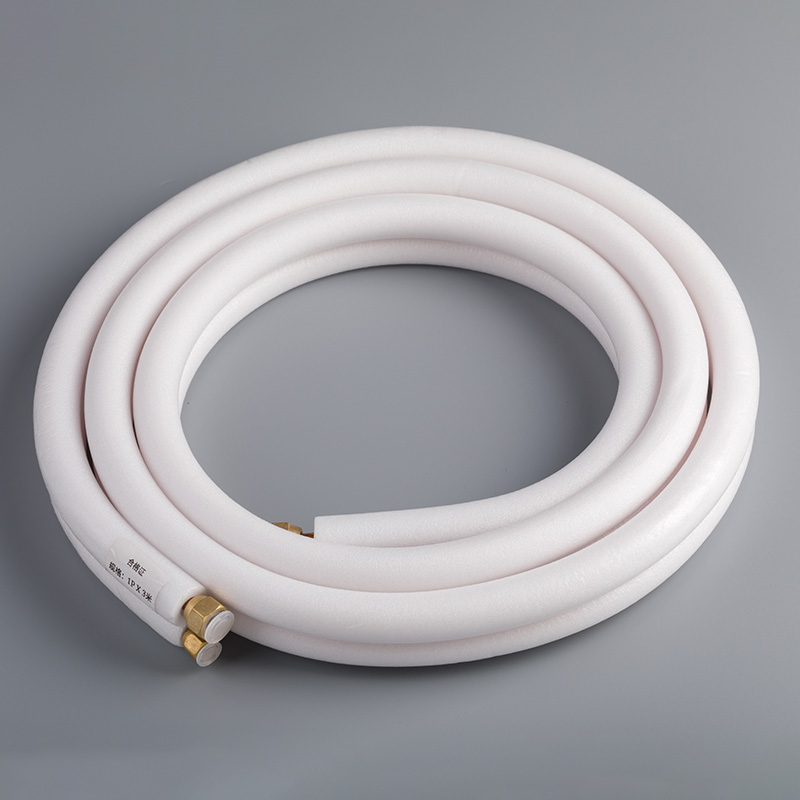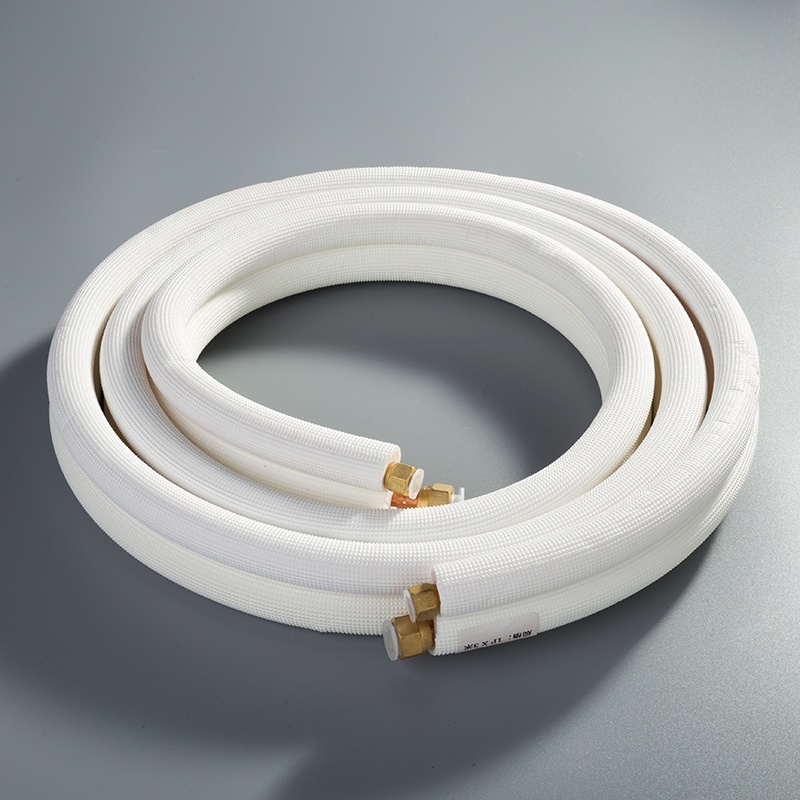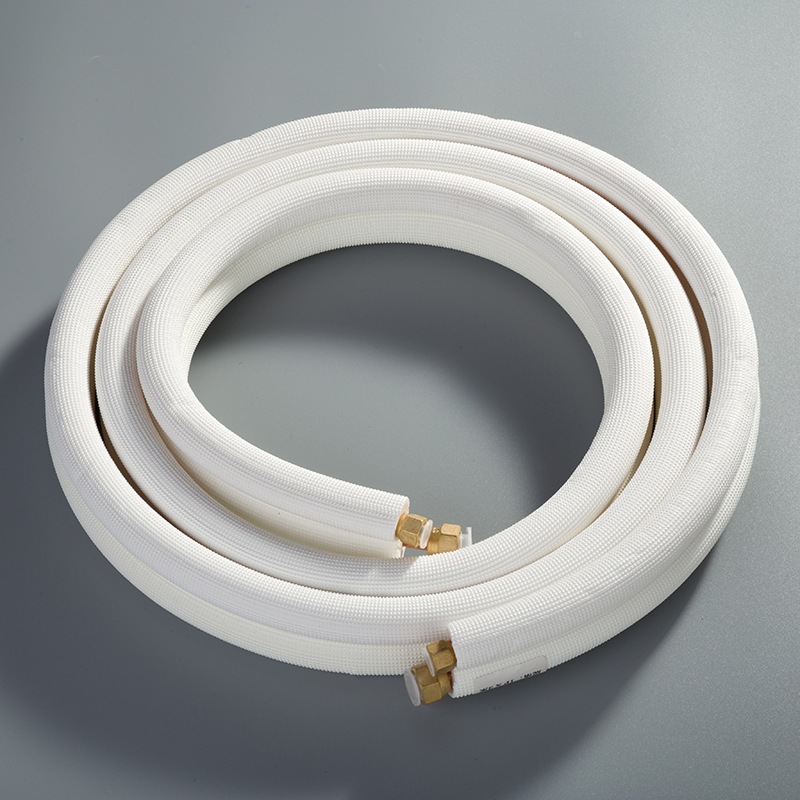How to Choose the Right Copper Pipe for Your Air Conditioner

Choosing the right copper pipe for your air conditioner is critical to ensuring its efficiency and longevity. Copper pipes stand out for their durability and resistance to corrosion, making them ideal for systems that handle refrigerants and water. Their excellent thermal conductivity allows for efficient heat transfer, which directly impacts energy efficiency and cooling performance.
Different types of air conditioner copper pipe offer unique benefits. For example, some provide higher pressure resistance, while others balance cost and performance. By selecting the right type, you can reduce the risk of leaks, extend the lifespan of your system, and improve overall reliability.
Key Takeaways
Pick the right copper pipe for your air conditioner. Type K is strong, Type L is affordable and sturdy, and Type M is cheap for low-pressure systems.
Use the correct pipe size to keep refrigerant flowing well. Wrong sizes can lower cooling or waste energy.
Choose refrigeration-grade copper pipes to work with modern refrigerants. This stops moisture problems and keeps the system reliable.
Think about the environment when using copper pipes. They can be recycled and are better for the planet than other options.
Check and care for your copper pipes often to avoid leaks or rust. Good maintenance makes your air conditioner last longer.
Types of Air Conditioner Copper Pipe

Type K Copper Pipe
Characteristics and Applications in Air Conditioning
Type K copper pipe has the thickest walls among all types of air conditioner copper pipe. This feature makes it highly durable and capable of withstanding high pressure. You will often find it used in HVAC systems where strength and reliability are critical. It is particularly suitable for high-pressure applications in air conditioning systems. Additionally, it is commonly used for water distribution and fire protection due to its robust nature.
Advantages and Disadvantages
The primary advantage of Type K copper pipe is its unmatched durability. Its thick walls provide excellent resistance to wear and tear, making it ideal for long-term use. However, this durability comes at a cost. Type K pipes are more expensive than other types of copper pipes, which might not make them the best choice for budget-conscious projects. Their thickness also makes them less flexible, which can complicate installation in tight spaces.
Type L Copper Pipe
Features and Suitability for AC Systems
Type L copper pipe strikes a balance between strength and cost-effectiveness. Its moderately thick walls make it durable enough for most residential and commercial air conditioning systems. You will find it suitable for a wide range of applications, including indoor and underground installations. Its versatility and reliability make it a popular choice for HVAC systems.
Pros and Cons of Type L Pipes
One of the biggest advantages of Type L pipes is their affordability compared to Type K pipes. They are easier to install and provide efficient cooling solutions for various projects. However, their durability is slightly lower than Type K pipes, which means they may not be the best option for high-pressure applications. Despite this, they remain a reliable choice for most standard air conditioning needs.
Type M Copper Pipe
When to Use Type M Pipes in Air Conditioning
Type M copper pipe has the thinnest walls among the types of air conditioner copper pipe. This makes it a cost-effective solution for low-pressure applications. You can use these pipes for supply lines that carry refrigerant from the compressor to the evaporator coils or for return pipes that bring refrigerant back to the compressor.
Benefits and Limitations
The main benefit of Type M pipes is their affordability. They are an excellent choice for projects with tight budgets. However, their thin walls make them less durable and unsuitable for high-pressure systems. If you need a copper pipe for low-pressure applications and want to save on costs, Type M pipes are a practical option.
ACR Copper Pipe
Why ACR Pipes Are Ideal for Air Conditioning Systems
ACR (Air Conditioning and Refrigeration) copper pipes are specifically designed for air conditioning systems. These pipes excel in performance due to their unique properties.
ACR pipes offer excellent thermal conductivity, which enhances the efficiency of heat transfer within your AC system. This ensures optimal cooling performance.
Their durability makes them reliable for long-term use. They resist environmental factors like moisture and internal pressures, reducing the risk of leaks or damage.
These pipes are relatively flexible, which simplifies installation. You can bend and braze them easily, making them suitable for complex configurations.
Corrosion resistance is another key advantage. This feature ensures that ACR pipes maintain their integrity over time, even in challenging conditions.
These qualities make ACR copper pipes a preferred choice for common applications in AC systems, especially where efficiency and reliability are priorities.
Key Features and Drawbacks
ACR copper pipes come with several notable features:
Feature | Benefit |
|---|---|
Thermal conductivity | Promotes efficient heat transfer, improving system performance. |
Corrosion resistance | Ensures longevity and reduces maintenance needs. |
Flexibility | Simplifies installation, especially in tight or complex spaces. |
Pre-cleaned and sealed ends | Prevents contamination, ensuring a clean refrigerant flow. |
However, ACR pipes also have some drawbacks:
They are more expensive than other types of copper pipes, which might not suit all budgets.
Their flexibility, while beneficial, may require careful handling to avoid kinks during installation.
Despite these limitations, ACR copper pipes remain a top choice for air conditioning systems due to their unmatched performance and reliability.
Key Factors for Choosing Copper Pipes
Pipe Size
Importance of Correct Sizing for Refrigerant Flow
Selecting the correct pipe size is crucial for maintaining the efficiency of your air conditioning system. The size directly affects the refrigerant flow rate and pressure. Pipes that are too small can restrict refrigerant flow, leading to reduced cooling performance. On the other hand, oversized pipes may cause inefficiencies and unnecessary energy consumption. Proper sizing ensures that your system operates at peak efficiency, reducing wear and tear on components.
How to Measure and Select the Right Size
When choosing copper pipes, you should consider several factors:
Follow sizing guidelines to ensure the correct flow rate and pressure.
Check the thickness standards to maintain structural integrity and durability.
Match the pipe diameter and wall thickness to your air conditioner's cooling capacity.
Evaluate the available installation space to avoid complications during setup.
Additionally, ensure the pipes meet national and industry quality standards. These steps will help you select the right size for optimal performance.
Compatibility with Refrigerants
Matching Copper Pipes with Modern Refrigerants
Copper pipes used in air conditioning systems must be compatible with modern refrigerants. Refrigeration-grade copper undergoes rigorous dehydration and sealing to prevent moisture contamination. This process is essential because moisture can react with refrigerants, causing corrosion and reducing efficiency. Using plumbing-grade copper instead of refrigeration-grade copper can lead to contamination and system failure.
Common Refrigerants and Their Compatibility
Refrigeration copper is specifically designed to work with common refrigerants like R-410A and R-32. These refrigerants require pipes that resist corrosion and maintain a clean refrigerant flow. Ensuring compatibility with AC refrigerants is vital for the long-term reliability and efficiency of your system.
Cost Considerations
Comparing Costs of Different Types of Copper Pipes
The cost of copper pipes varies depending on their type and application. Type K pipes are the most expensive due to their thick walls and high durability, making them ideal for high-pressure systems. Type L pipes offer a balance between cost and durability, making them suitable for residential and commercial use. Type M pipes are the most affordable option, but their thinner walls make them less durable and suitable only for low-pressure applications.
Balancing Affordability with Quality
When considering cost, you should weigh affordability against quality. While Type M pipes may save money upfront, they might not last as long as Type K or L pipes. Investing in higher-quality pipes can reduce maintenance costs and improve efficiency over time. By evaluating your system's needs and budget, you can make an informed decision when choosing copper pipes.
Environmental Impact
Sustainability and Recyclability of Copper Pipes
Copper pipes offer a sustainable solution for air conditioning systems. Unlike many other materials, copper is infinitely recyclable. This means you can reuse it repeatedly without losing its quality or performance. Recycling copper requires significantly less energy compared to mining new copper. In fact, it uses 85% less energy, which helps conserve natural resources and reduces the environmental damage caused by mining activities.
When compared to alternatives like multilayer plastic pipes, copper stands out as a more eco-friendly option. Plastic pipes often contain multiple layers of different materials, making them difficult to recycle. Separating these materials is a complex process, and many claims about their recyclability are exaggerated. Copper, on the other hand, benefits from an efficient scrap-collecting system. This ensures that used copper pipes are collected, recycled, and reintroduced into the production cycle, minimizing waste and promoting sustainability.
Eco-Friendly Practices for Copper Pipe Usage
You can adopt several eco-friendly practices when using copper pipes in air conditioning systems. First, consider sourcing recycled copper pipes whenever possible. This reduces the demand for newly mined copper and supports the recycling industry. Second, ensure proper installation and maintenance of your copper pipes. Well-maintained pipes last longer, reducing the need for replacements and minimizing waste.
Additionally, dispose of old copper pipes responsibly. Many recycling centers accept copper scrap, ensuring it gets processed and reused instead of ending up in landfills. By choosing copper pipes and following these practices, you contribute to a more sustainable and environmentally friendly air conditioning system. 🌱
Tip: Opting for copper pipes not only benefits your AC system but also helps protect the planet by reducing energy consumption and waste.
Installation and Maintenance Tips for Copper Pipes

Installation Best Practices
Proper techniques for cutting and fitting copper pipes
Using proper installation techniques ensures the efficiency and longevity of copper pipes in your HVAC system. Precision is key when cutting and bending copper pipes. Use high-quality tools like pipe cutters and reaming tools to achieve clean cuts and smooth edges. This minimizes the risk of leaks and ensures a secure fit. Accurate measurements are equally important. Measure twice before cutting to avoid errors that could lead to improper connections.
When fitting copper pipes, ensure tight and secure joints. Use appropriate brazing or soldering methods to create leak-proof seals. Proper insulation is also crucial. Insulating the pipes prevents condensation, which can lead to water damage or corrosion over time.
Avoiding common installation errors
Avoiding mistakes during installation can save you from costly repairs later. Poorly executed pipe joints often result in leaks. Ensure all connections are properly sealed and tested before completing the installation. Another common error is inadequate insulation. Without proper insulation, condensation can form, leading to potential damage. Always use high-quality insulation materials to protect your copper pipes.
Tip: Double-check your work during installation to catch any errors early. This simple step can prevent major issues down the line.
Maintenance Guidelines
Regular inspections for leaks and corrosion
Regular maintenance is essential for keeping your copper pipes in top condition. Inspect the pipes periodically for signs of wear, corrosion, or leaks. Look for oil stains, bubbles, or discoloration on the pipe surface, as these often indicate leaks. Check connection points for looseness or damage. Early detection of issues can prevent costly repairs and extend the lifespan of your system.
Cleaning and upkeep for long-lasting performance
Cleaning your copper pipes helps maintain their efficiency. Use mechanical cleaning tools like abrasive cloths to remove debris or buildup. For tougher corrosion, chemical cleaning methods such as citric acid solutions can be effective. Avoid harsh cleaning agents that might damage the pipes. Regular cleaning ensures optimal performance and contributes to long-term cost efficiency.
Troubleshooting Issues
Identifying and resolving leaks or blockages
Leaks and blockages are common issues in copper piping. To identify leaks, inspect the pipes for visible damage or listen for hissing sounds. Blockages often result from debris buildup. Use mechanical tools to clear minor blockages or consult a professional for severe cases. If you notice freezing in the pipes, it may indicate low refrigerant levels. Topping up the refrigerant can resolve this issue, but damaged pipes might require replacement.
Knowing when to replace copper pipes
Sometimes, repairs are not enough. Replace copper pipes if you notice severe corrosion, deformation, or persistent leaks. Regular inspections help you identify these signs early. Replacing damaged pipes ensures the reliability of your HVAC system and prevents further complications.
Note: Timely replacement of worn-out pipes can save you from unexpected system failures and costly repairs.
Choosing the right copper pipe ensures your air conditioning system operates efficiently and lasts longer. Factors like pipe type, size, refrigerant compatibility, and cost play a crucial role in making the best choice. Consulting professionals or trusted suppliers can simplify this process:
They provide insights into pipe types and installation techniques.
They highlight refrigerant compatibility and ensure compliance with industry standards.
They recommend reliable brands and solutions tailored to your cooling needs.
Copper pipes resist corrosion and offer unmatched durability, making them a sustainable and reliable option. For expert guidance, always rely on reputable sources.
Tip: Investing in the right copper pipe today saves you from costly repairs tomorrow.
FAQ
What type of copper pipe is best for residential air conditioning systems?
Type L copper pipes work best for residential AC systems. They balance durability and cost-effectiveness, making them suitable for most homes. Their moderate wall thickness ensures reliable performance without being overly expensive.
Can you reuse old copper pipes for a new air conditioning system?
Yes, you can reuse old copper pipes if they are in good condition. Inspect them for corrosion, leaks, or damage. Clean them thoroughly to remove contaminants. If they show significant wear, replacing them ensures better performance.
How do you prevent copper pipes from corroding?
Use proper insulation to protect copper pipes from moisture. Regularly inspect and clean them to remove debris or buildup. Avoid exposing them to harsh chemicals. These steps help maintain their integrity and extend their lifespan.
Are ACR copper pipes worth the higher cost?
Yes, ACR copper pipes are worth the investment for air conditioning systems. Their pre-cleaned, sealed ends and corrosion resistance ensure optimal refrigerant flow and long-term reliability. They simplify installation and improve system efficiency.
How do you know when to replace copper pipes in your AC system?
Replace copper pipes if you notice severe corrosion, persistent leaks, or deformation. Regular inspections help identify these issues early. Timely replacement prevents system failures and ensures efficient cooling performance.
Tip: Always consult a professional if you're unsure about the condition of your copper pipes.
See Also
The Benefits Of Using Copper Pipes In Air Conditioning
Pure Copper Pipes: Essential For Air Conditioning Efficiency
The Impact Of Pure Copper Pipes On Air Conditioning


